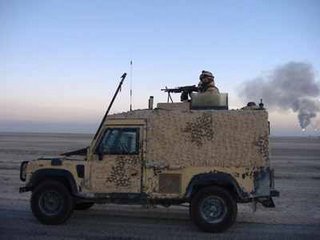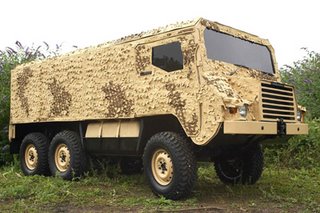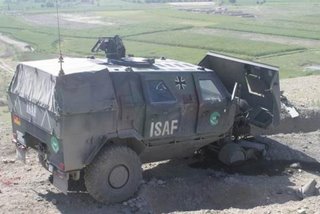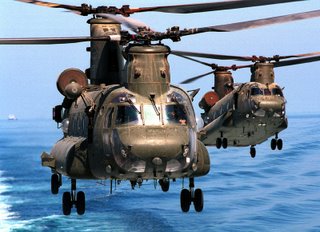 It is a reflection of how deeply ingrained is my distrust for government that the last place I would think of looking for information on the armed forces is the MoD website – especially since it was "improved", whence most of the archives have rather conveniently gone missing.
It is a reflection of how deeply ingrained is my distrust for government that the last place I would think of looking for information on the armed forces is the MoD website – especially since it was "improved", whence most of the archives have rather conveniently gone missing.Anyhow, one of our readers pointed me in that direction and, lo and behold, we have a picture of the new armoured vehicle which the MoD is purchasing for our troops in Iraq. The photograph, supplied by Force Protection Inc, is of a 6x6 Cougar variant and, from the colour scheme, it is definitely one of the batch originally destined for the Iraqi Army, known as the Iraqi Light Armoured Vehicle (ILAV).
 There is an extremely good article on this here (which links to some essential reading here) and the indispensable Defense Industry Daily gives a good narrative of the MoD contract here.
There is an extremely good article on this here (which links to some essential reading here) and the indispensable Defense Industry Daily gives a good narrative of the MoD contract here.Just what the Iraqi Army feels about the MoD jumping the queue has not been recorded but it is more than a little rum that, at a time when the Iraqis are being asked to assume greater responsibility for internal security, the British step in and swipe their vehicles from them, leaving the people who are most at risk to ride around in unprotected or lightly armoured vehicles.
If there is a comedic aspect to this, it is Lord Drayson, the defence procurement minister, who having told us of the RG-31, as recently as 29 June, that "we judged the size and mobility of the vehicle not to be appropriate to the needs of our Armed Forces today", is now buying something a foot wider and higher, and nearly four feet longer. Incredibly, it is nearly ten feet longer than the Snatch Land Rover and three feet wider and taller.
 But there is nothing at all comic about the choice of the Pinzgauer Vector, a picture of which is also up on the MoD website. Bought primarily for its cross-country performance – which is superb – the MoD is calling this a "Protected Patrol Vehicle". With its slab sides and lack of window in the troop compartment, it is hard to believe the MoD is serious about this being used for patrols. The soldiers inside will be sightless passengers, guarded only by an unfortunate soldier (or two) with his head stuck out the roof as "top cover", terrified that the vehicle will overturn (as top-heavy, cross-country vehicles are prone to), crushing him to death.
But there is nothing at all comic about the choice of the Pinzgauer Vector, a picture of which is also up on the MoD website. Bought primarily for its cross-country performance – which is superb – the MoD is calling this a "Protected Patrol Vehicle". With its slab sides and lack of window in the troop compartment, it is hard to believe the MoD is serious about this being used for patrols. The soldiers inside will be sightless passengers, guarded only by an unfortunate soldier (or two) with his head stuck out the roof as "top cover", terrified that the vehicle will overturn (as top-heavy, cross-country vehicles are prone to), crushing him to death. As for "protected", that it ain't, except against the lightest of threats. The vehicle, as we have observed before (here and here) offers no protection against anti-tank mines, which are available in abundance in Afghanistan – a fact to which the Germans and the Canadians will attest. The latter, having recently lost four men travelling in a lightly armoured G-Wagon (the Mercedes equivalent to the Land Rover) are now counting their good fortune that the next mine strike hit troops driving in an RG-31.
As for "protected", that it ain't, except against the lightest of threats. The vehicle, as we have observed before (here and here) offers no protection against anti-tank mines, which are available in abundance in Afghanistan – a fact to which the Germans and the Canadians will attest. The latter, having recently lost four men travelling in a lightly armoured G-Wagon (the Mercedes equivalent to the Land Rover) are now counting their good fortune that the next mine strike hit troops driving in an RG-31.While there is some considerable debate about the benefits of mine protected vehicles in dealing with IEDs – which plague the coalition forces in Iraq - the situation in Afghanistan is different. In Iraq, most of the roads have metalled surfaces – which is why the insurgents resort to roadside bombs - but, in Afghanistan, huge areas are accessible only by unmade roads, which favour the use of mines.
Perhaps millions of mines are left over from the Soviet era and the accounts of the Red Army experience during their occupation show that most of their casualties came from mine strikes. In putting these Pinzgauers into Afghanistan, the MoD are out of their tiny minds… they are criminally insane.
 As opposed to mine protected vehicles, however, often the most appropriate way of protecting troops is to use helicopters. There, of course, we bump up against reality – the cupboard is bare.
As opposed to mine protected vehicles, however, often the most appropriate way of protecting troops is to use helicopters. There, of course, we bump up against reality – the cupboard is bare.Here though, is an interesting reflection for a site named "EU Referendum". Something that has haunted me from my days in the European Union Parliament is the cohorts of preening MEPs, each of whom cost the British taxpayer £1.2 million a year. Many would tell me how vital their roles were, in increasing British influence in the EU.
When it comes down to real influence, however, in the real world this turns out to have more to do with how many helicopters the British can field. With 78 British MEPs at present, costing us over £90 million a year, that is the price of five Chinook helicopters a year with change left over. Somehow, I suspect – given a choice – most people would opt for the Chinooks.
Similarly, for the £11 billion a year we pay in "contributions" to the EU each year – nearly twice our annual defence procurement budget – I suspect we could buy a great deal more influence if we spent it on "toys" – provided, of course, we did not fritter it away on the European Rapid Reaction Force, and spent it on kit that was actually fit for purpose.
COMMENT THREAD